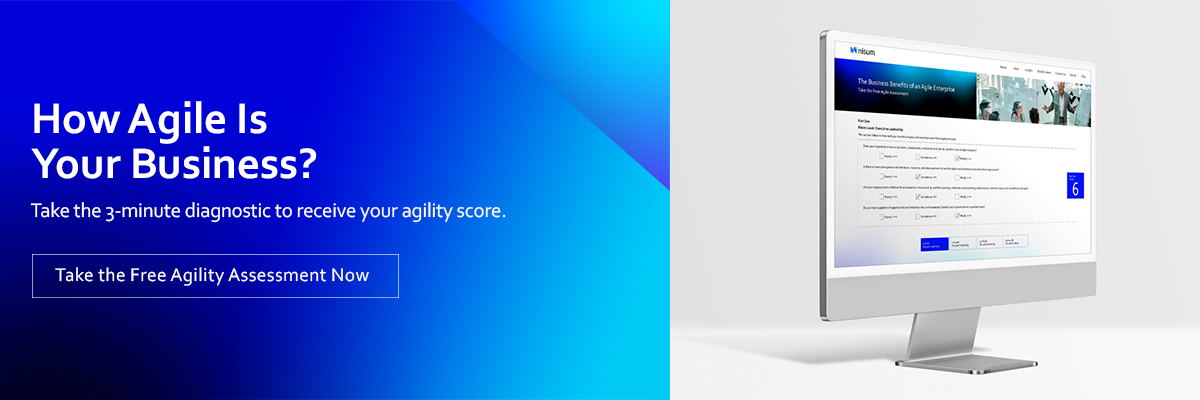 Picture Credit: Unsplash
Picture Credit: Unsplash
The existing situation with COVID-19 has jolted everyone into realizing that enterprises have to be nimble and have the agility to adjust to sudden changes. Many organizations have adopted Agile methodology, but not many have scaled it to an enterprise-level - where Agile is applied from ideation to strategic planning and execution.
A State of Agile report states that as of 2019, 97% of companies are Agile, but of this only 22% are “fully” Agile. Here are some symptoms to recognize the lack of enterprise-level agility.
1. You Have Silos in the Organization
One of the main benefits of an Agile delivery methodology is to shine a light on those functional dark corners and usher invisibility. It also enhances collaboration with the various teams. However, if you find that there are pockets of the organization that have walls around it, perhaps due to various departments having a different flavor of processes that are not visible to other departments and require formalized ways of communication, there is room for improvisation in the processes for better collaboration. Having a common language and processes across the organization helps to break down the walls of the silos.
2. To Implement a Data-driven Culture for Planning
Most of the time, executives view Agile adoption as an aggressive means to meet deadlines.
The lack of formal training at the executive level of the Agile methodology and mindset results in an “old” way of managing teams and their expectations of them. They continue to drive teams by pushing artificial deadlines and dates. This goes against the basic principles of an Agile way of working and prioritizing work. The planning is done only at the team level and does not align across all functions. This causes a chaotic delivery culture. The functional teams work in an Agile fashion but cannot reap the complete benefits of the methodology, as the various cross-functional teams are not working in harmony. Scaling Agile to an enterprise-level offers a way to align all functional teams towards common goals. It helps to plan at a portfolio level and break the annual goals into quarterly milestones across the cross-functional teams.
3. To Strategically Align Business and Products
A project-based organization results in misalignment in business priorities and project planning. A product-based organization creates a structure where the departments are organized according to the functional specialization resulting in stable teams of specialized workers who can evolve as high-performing and predictable teams.
Do you have project teams that constantly tear up and down? Are you constantly shuffling your specialized employees to various projects and having them work partially on multiple projects?
Not having stable teams results in de-motivated and disengaged employees. Specialized workers get burnt out as they have to help and support multiple initiatives. It also gets difficult to support business and changing priorities as there are multiple projects in flight and they may conflict with each other with respect to resource and capacity planning.
A 2019 Gartner report showed that 85% of the organizations have either adopted or plan to adopt a product-centric delivery methodology. A product-based organization greatly aids in product level funneling and portfolio planning which in turn, helps in better alignment with business and market needs.
4. To Stay Flexible Within Changing Environments
We are in a fast-paced and dynamic environment that is constantly changing. To keep up with unpredictable market conditions, organizations have to get to where adjusting to change is easy and streamlined.
There are structures and processes in place by which a change in direction can easily be absorbed by the teams and does not disturb the ecosystem. Normally, in the face of a catastrophe such as the one we are currently facing, organizations come to a halt in order to re-evaluate, re-plan, and change their direction. This is mainly due to centralized decision-making and a top-down approach to an overall strategy. Similarly, reaction to opportunities may also be slow and may result in organizations losing their competitive edge. Adoption of an Agile mindset at an enterprise level can help organizations react faster to threats and opportunities and remain customer-centric. This approach builds brand value in the market. Being nimble in taking decisions also helps the organizations to fail fast and learn from their mistakes to provide better value to their customers.
5. To Create a Culture of Innovation
Do you have employees who are bored, just do what they are told, and don’t keep their commitments?
This may be because they are not feeling empowered to make a difference and are not appreciated for it. This culture can result in organizations missing out on their full potential to grab market share. In order to keep up with the competition and dynamic market conditions, it is crucial to create a culture of innovation, not just at the team level but across the entire organization. Building an innovation culture requires enthusiastic and motivated employees who are eager to learn and think out of the box.
One of the core principles of the Agile methodology is, “Build projects around motivated individuals. Give them the environment and support they need, and trust them to get the job done.”
Building self-organized teams are the building block for an innovative culture. It helps to create a bottom-up leadership with employees feeling more empowered to take more ownership and accountability for decisions.
To Be Agile Needs a Mindset Shift
Scaling Agile methodology to an enterprise-level is a paradigm shift and requires executives to gain a deep understanding of ‘being’ Agile. For organizations to be more flexible to market changes and grab market share early to build brands, building a product-centric, innovative culture, and a bottom-up leadership approach can go a long way. It requires patience and practice.
How Nisum Can Help
If you need help scaling your Agile processes to the Enterprise level or build a product-centric organization, contact us. Large organizations have found that Nisum gives them a competitive edge through lean and Agile coaching. They’re using Nisum to build change management systems that address key organizational challenges related to team efficiency and product centricity.




